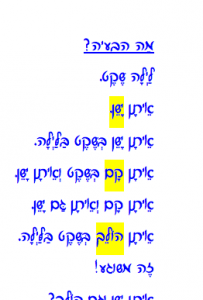During training day 1 or 2, Lori, our education director suggested integrating aspects of modern Israeli life/culture into our language instruction, and while I’m not convinced of its role for novices, (and I’ll probably blog about that topic sometime soon), I took up her challenge…sort of. I decided that our week 2 extended story-asking demo in Hebrew would be based on a cute Israeli TV commercial. It would serve as my inspiration and qualify as an authentic resource! (Oy. Don’t even get me started on that topic!) I planned to ask a story, dramatize, read, and finally show the clip – as a nice Social Studies-esque tie-in.
This phase of ‘lesson planning’ is critical for T/CI teachers: Choosing a prompt or storyline or just some high frequency and/or compelling structures, and deciding what other language they will use with their students to talk and ask about. Often we teachers go way too wide, stuffing a simple storyline with 6 or 10 verb structures or forms, lots of glue and transition words, some rejoinders and other new-sounding vocab. But we must err on the side of simple and narrow, (I say this to remind myself, too!) especially for novice learners. In the case of our temple students, we will assume they are all absolute beginners in Hebrew, even though some are ‘sloshers’ (this is Terry Waltz’s excellent term), who have isolated words and phrases, songs, poems, prayers and other memorized chunks from past instruction sloshing around their brains. Because they have not been exposed to comprehensible, compelling and contextualized extended discourse in Hebrew, we will start building their Hebrew foundation slowly, from the ground up.
Back to the story and the clip. It’s about a guy who’s sleeping. He gets up and sleepwalks to the fridge, which is empty, then to the supermarket, which is also empty. Bingo!! We have a classic storyline – someone wants or needs something and goes from location to location to find it!
We began asking and dramatizing the plot in our training session. I instructed one of the teachers to lay down and pretend to sleep…then open her mouth in search of something to eat. We had her sleepwalk all over the temple library – we even had her open the fridge in the adjacent kitchen! On my cuing, she considered but rejected several of the offerings on the breakfast buffet – the yogurt, the banana, the bagel – until she found something she liked, “woke up,” and pretended to eat it. The end.
According to Terry Waltz’s Cold Character Reading (CCR) protocol, the students must hear and comprehend target structures around +- 70 times apiece in an oral class, then have the written version reinforce these target structures another 30 times or so. I wrote up the Hebrew story, What’s the problem? but with slight variation for interest, matching the action of the as yet un-screened clip. I tried to get dozens of repetitions on my targets: ‘is sleeping’ and ‘walks’ as well as the words for ‘There is/are” and “There isn’t/aren’t.” (A few other verb forms in the story, like ‘gets up’ aren’t really targeted – let’s assume students already know ‘gets up’ from beginning-of-year Total Physical Response [TPR] – Get up, sit down.) ?מה הבעיה (What’s the Problem?) is an example of a simple story line stretched out and massaged into an episodic extended block of text with lots of patterned repetition.
BTW, I count the following # of reps on my targets in the reading: Sleeps = 12; walks = 12; there is = 18; there isn’t = 13. I’ll try to double up next time! These ballpark numbers are for the decoding magic of Cold Character Reading to work; if students are already decoding well in Hebrew, then this is a fine classic CI story with adequate contextualized reps to boost comprehension and retention!
The teachers found it so satisfying to read, and deepened their understanding of how the earlier barrage of comprehensible, compelling and contextualized auditory input prepares their students for successful reading (more input).
Oh, and here’s the YouTube link to the commercial for Yotvata Chocolate Milk. Enjoy!
